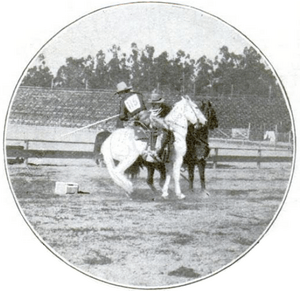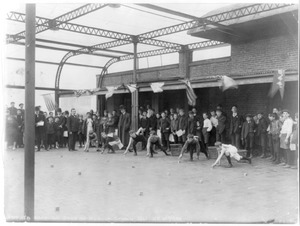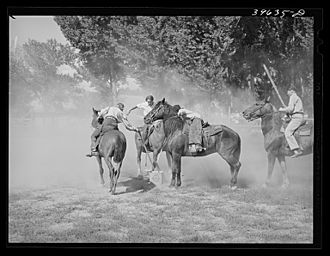Potato race facts for kids
A potato race is a fun competition where people try to collect a bunch of potatoes as fast as they can. Contestants might run on foot or ride on horseback. This type of race became popular in countries like Australia, England, Scotland, the United States, and Wales. Potato races were often part of community events like county fairs, rodeos, picnics, and track and field meets from the mid-1800s until about the 1930s. Today, you can still find potato races at some local gatherings or riding events.
Foot Races
Potato races run on foot were usually for children. They were often played as games in school playgrounds or during physical education classes. These races were also popular at local events like picnics or fairs, and sometimes still are today.
Here's how a foot race usually works:
- Several lanes are marked out, one for each runner.
- Potatoes are placed at different spots along each lane.
- A basket is set up a few feet behind the starting line for each runner.
- Runners race to pick up one potato at a time.
- They must bring each potato back to their basket before going to get the next one.
- The first person to collect all the potatoes in their lane wins!
In one version, two runners would race to collect fifty potatoes. They would both try to grab the closest potato from a single line of one hundred potatoes. The first one to fill their basket won.
Mounted Races
Mounted potato races were mostly for adults. They were very popular in the Southwestern United States. In these races, riders used sharp sticks to spear potatoes. They would carry the potatoes from one end of a course to a basket at the other end. The winner was the rider whose basket had the most potatoes at the end of a set time.
Individual Competition
In some individual mounted races, a line of potatoes was spread out along a course. A rider would gallop by, leaning down from their horse to snatch the potatoes from the ground. Riders who slowed down or missed a potato were out of the race. The fastest rider who collected all their potatoes won.
Potato races have also been held with people riding vehicles instead of horses. In 1897, there was a bicycle-mounted potato race. In 1908, young women rode bicycles in a potato race at a large picnic in England. In 1910, people at the Indianapolis Motor Speedway watched a "reverse" potato race. Passengers in cars tried to throw potatoes from their car into baskets along the track. In 1970, the First Annual Motorcycle Rodeo even had a potato race with riders on motorcycles.
Team-Based Competition
Swinging their laths like swords and crashing into one another, potato racers at Cassoday left the hundred-yard course strewn with potatoes and an occasional horseman as spirits, and tempers, rose.
—Jim Hoy, Plains Folk: A Commonplace of the Great Plains, p. 126
Around the early 1900s, some mounted potato races were played between teams. Teams tried to fill a basket with potatoes. These events were often very wild and could last up to ten minutes. Riders were not limited to lanes, and they could use their sticks to knock potatoes off other teams' sticks. These races could get very competitive. One cowboy, Harry Arthur Gant, wrote about a team race in 1909 that became so intense the judges had to stop it. It was said that pulling riders off their horses was allowed, and "biting is about the only thing that is barred."
Images for kids
-
Boys running a potato race in Ridgway, Colorado during a Labour Day celebration in 1940.





